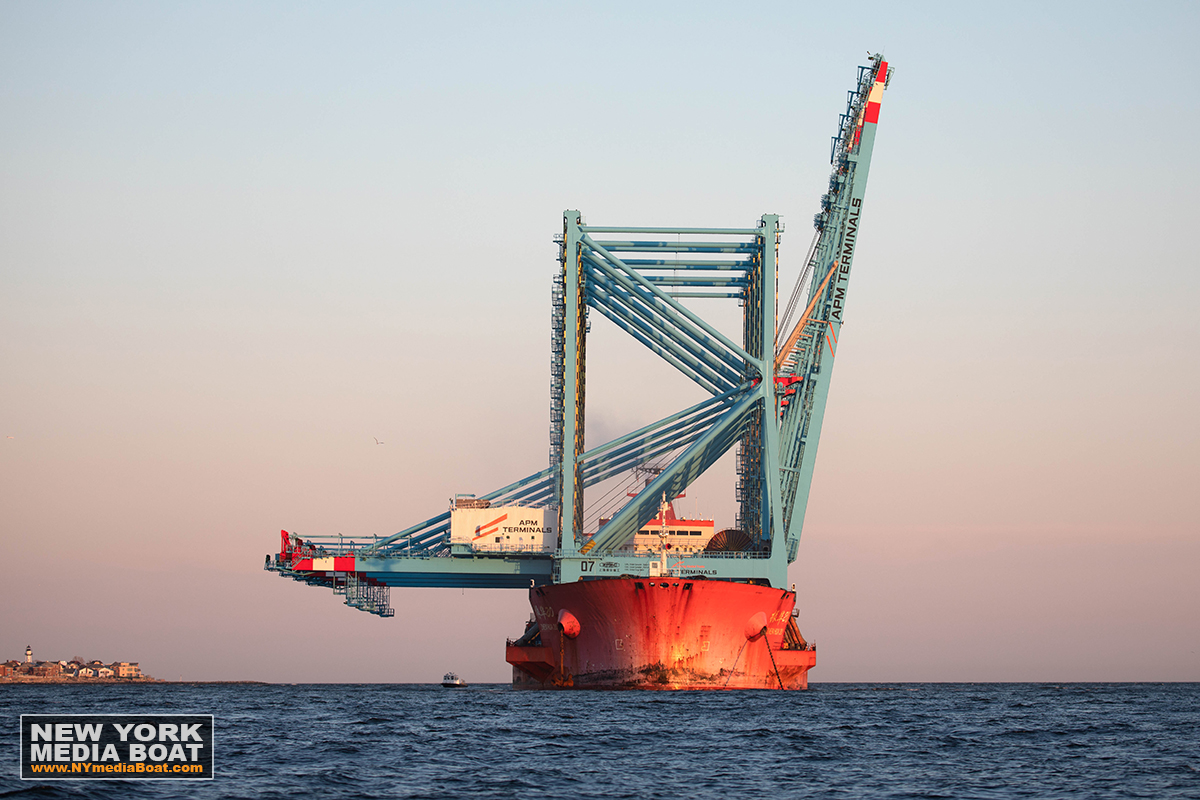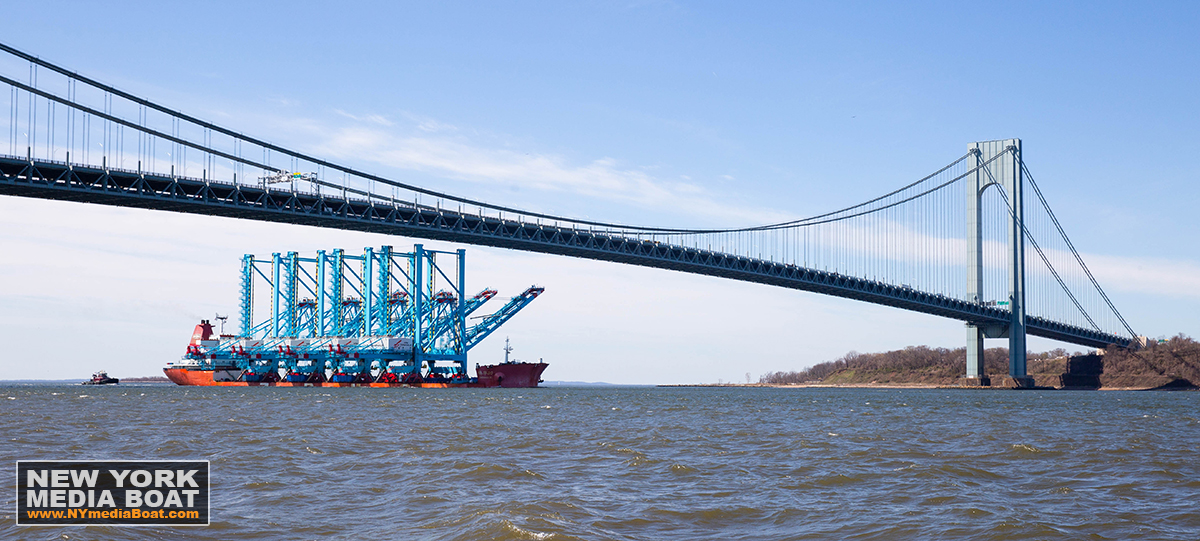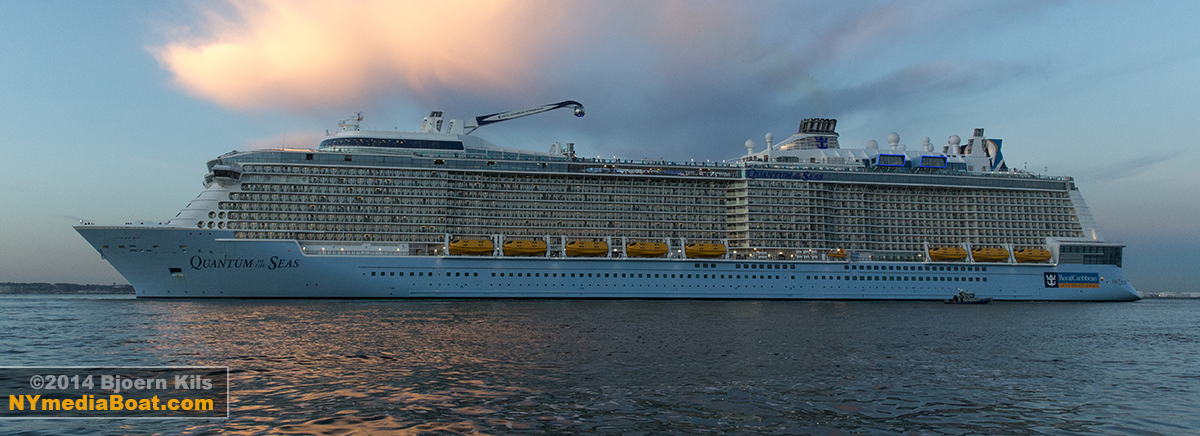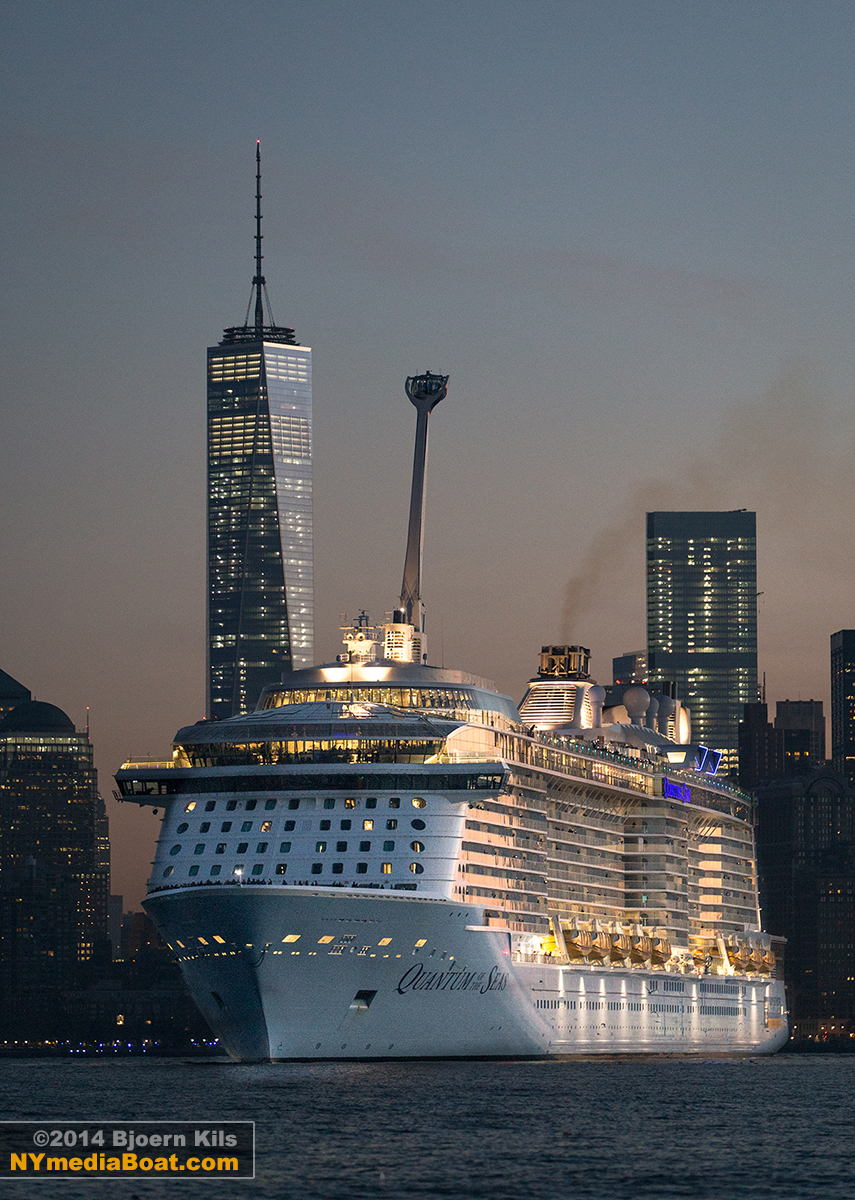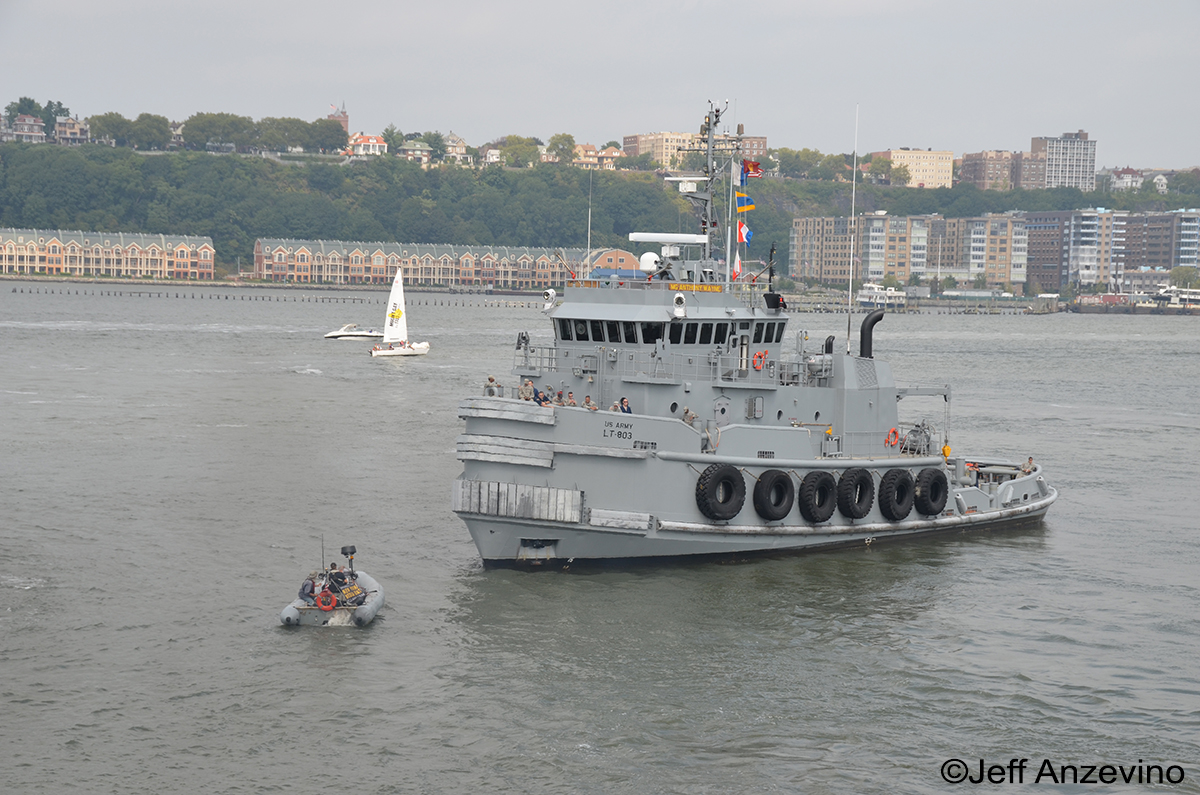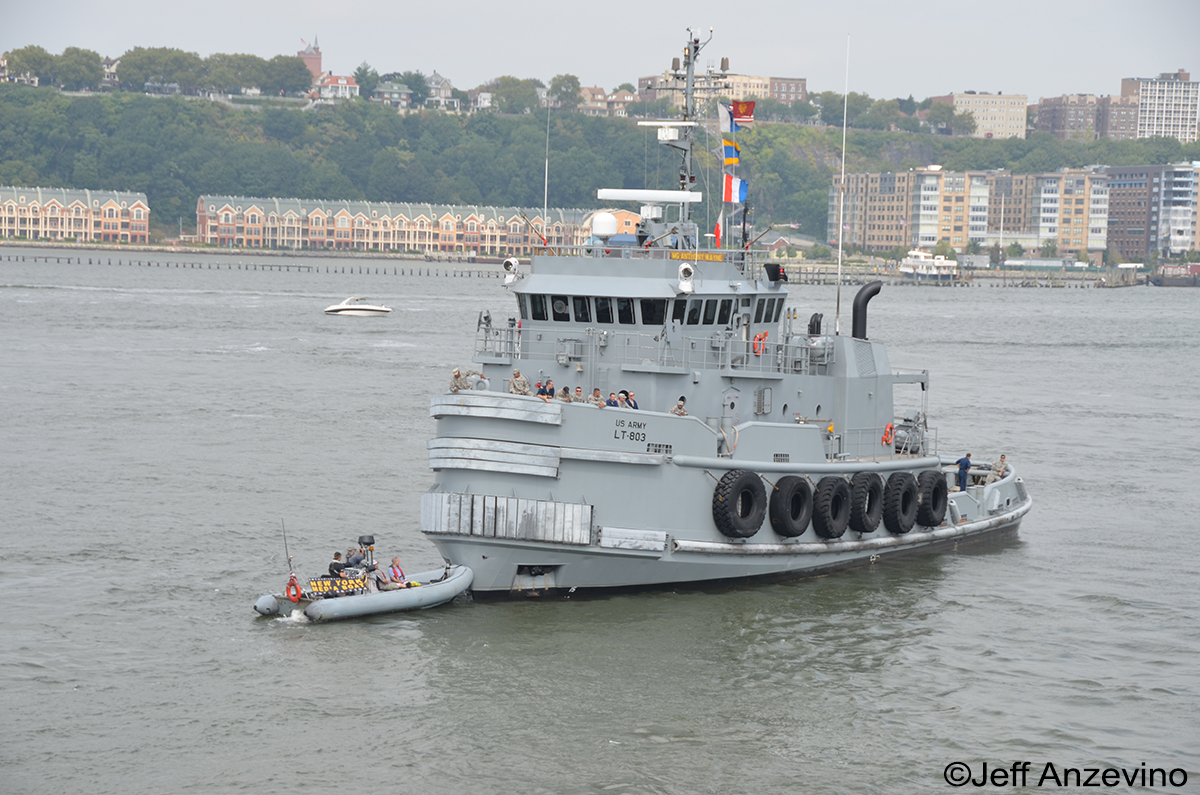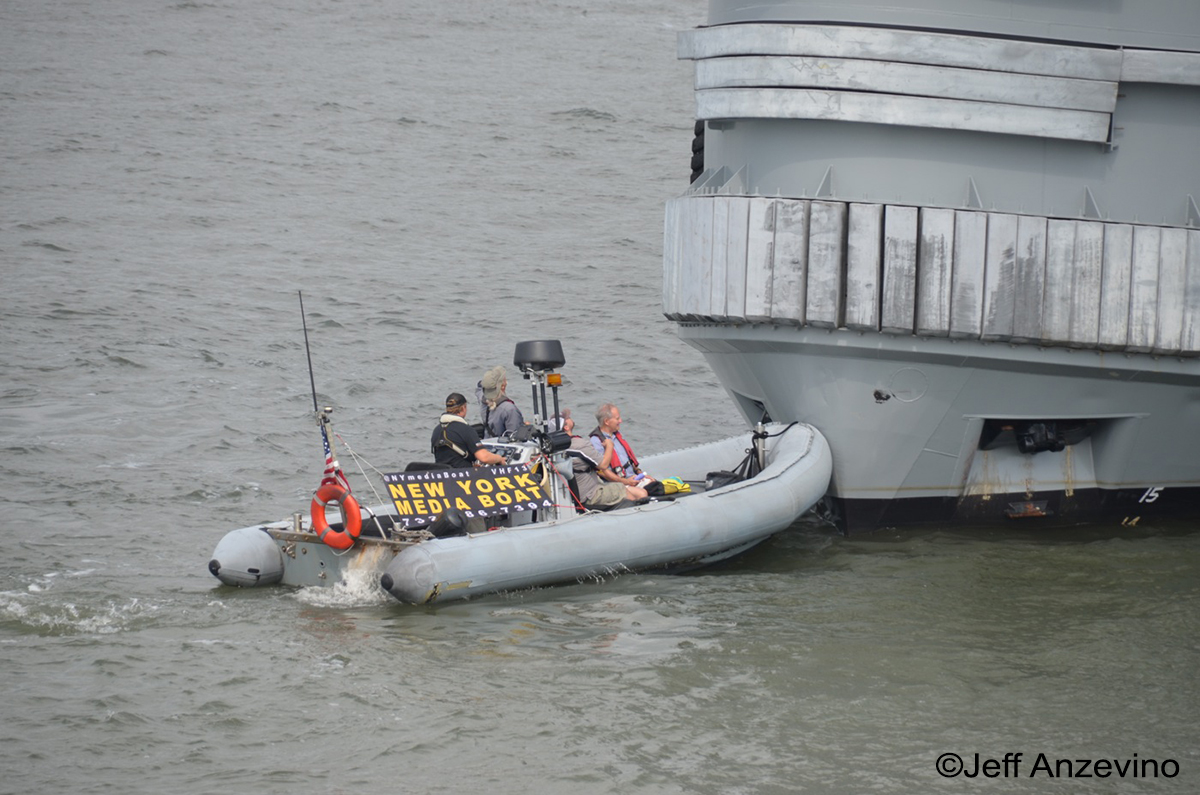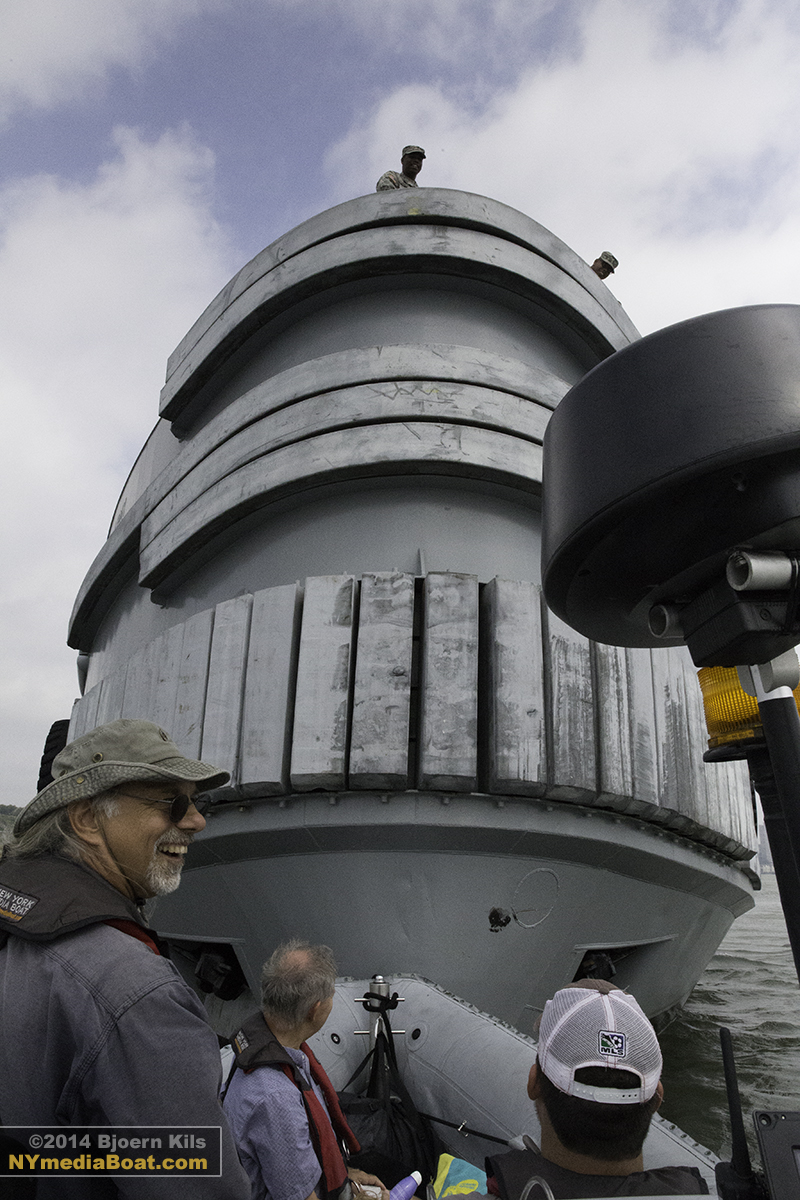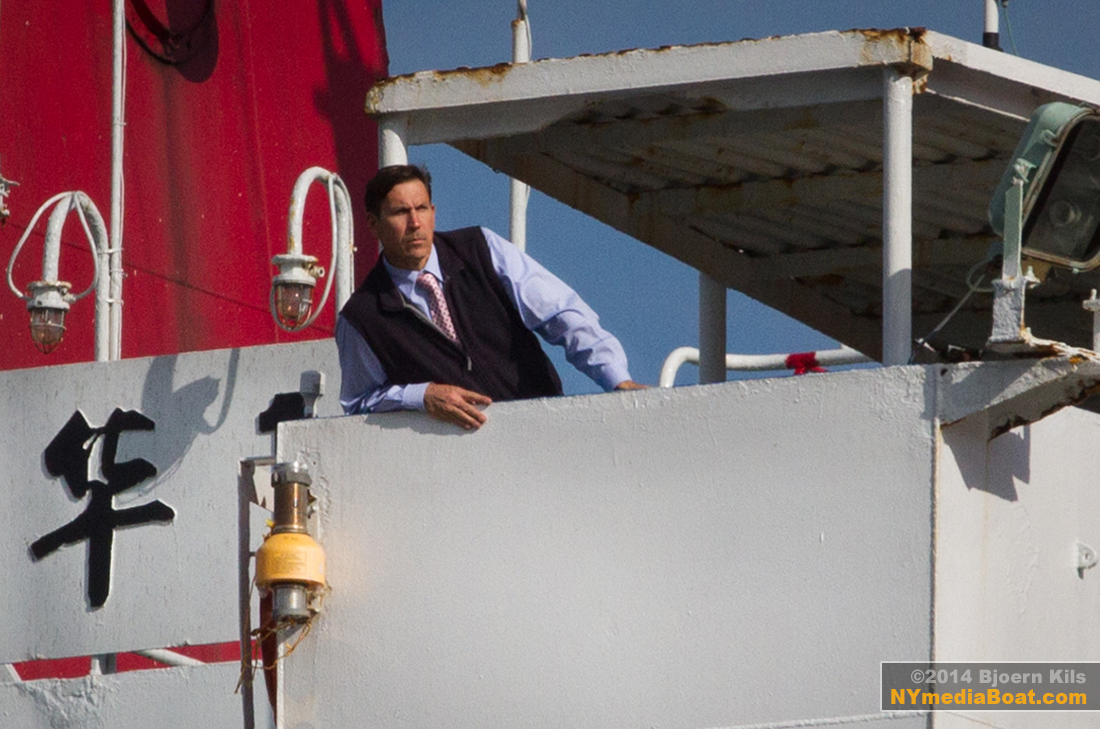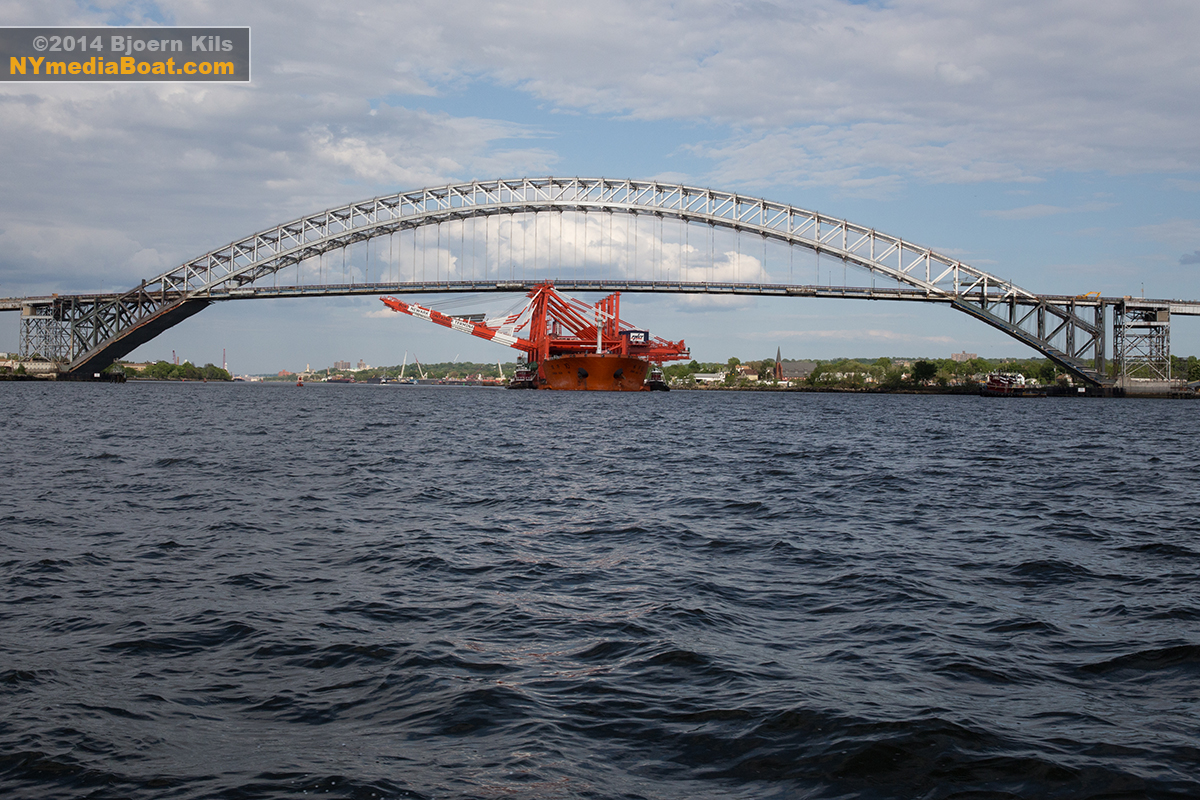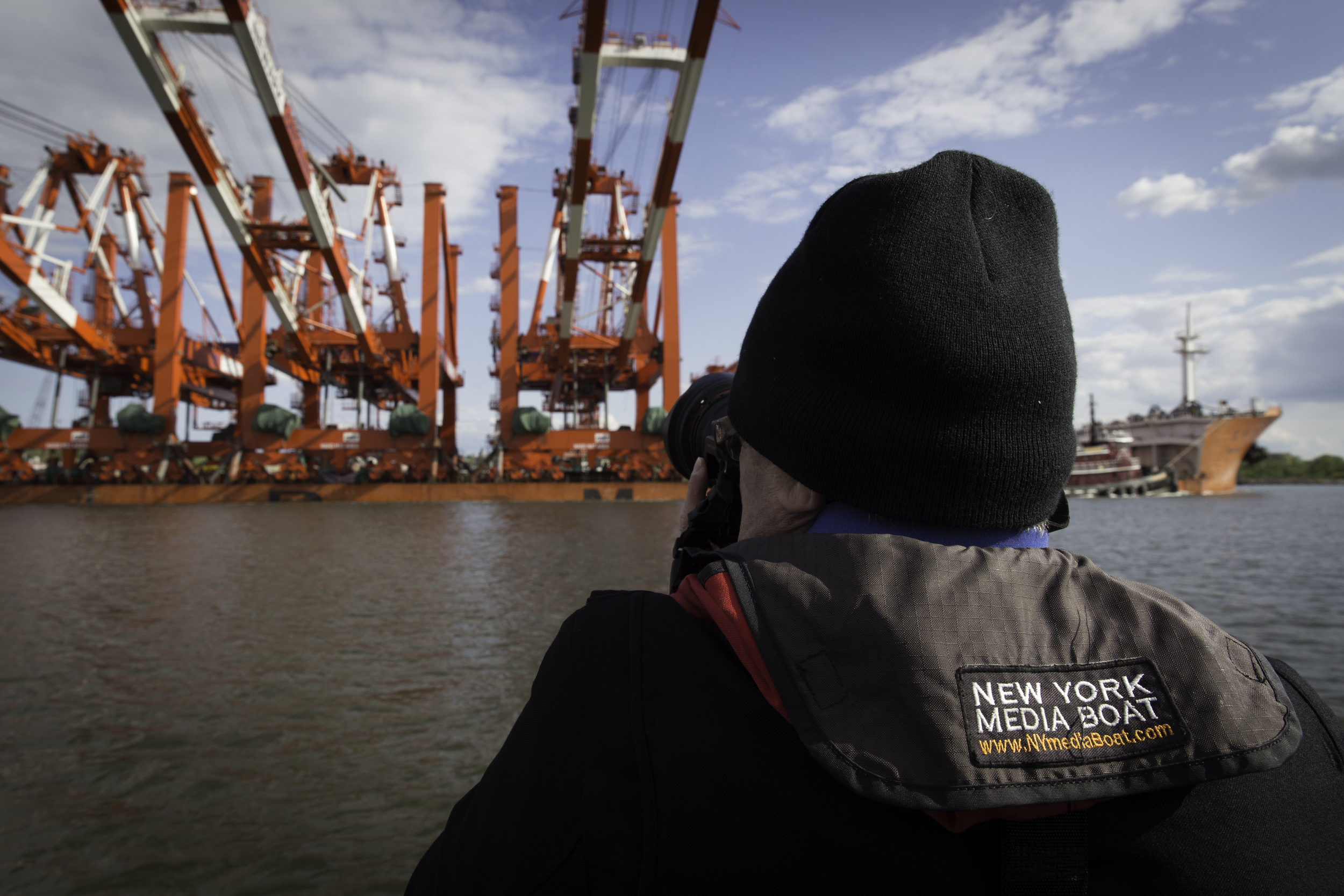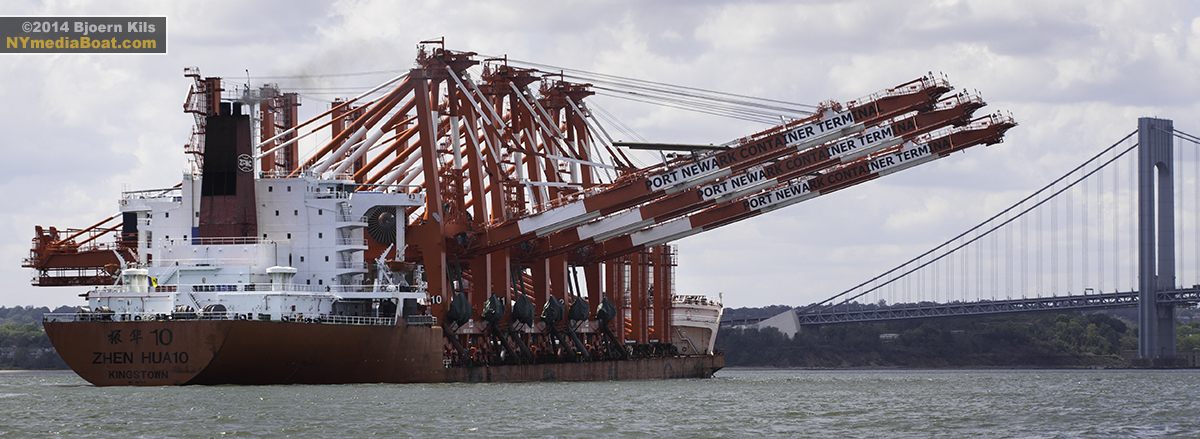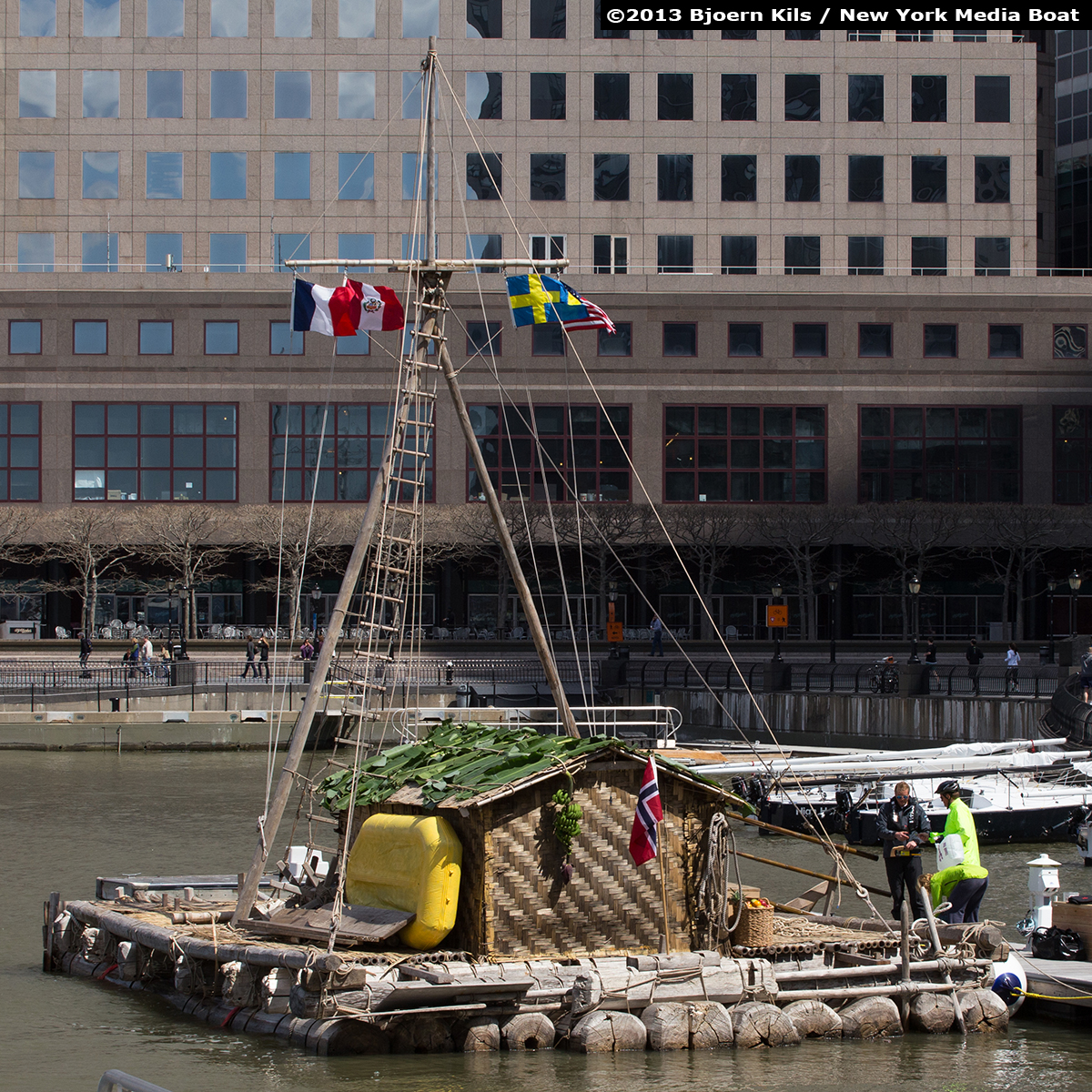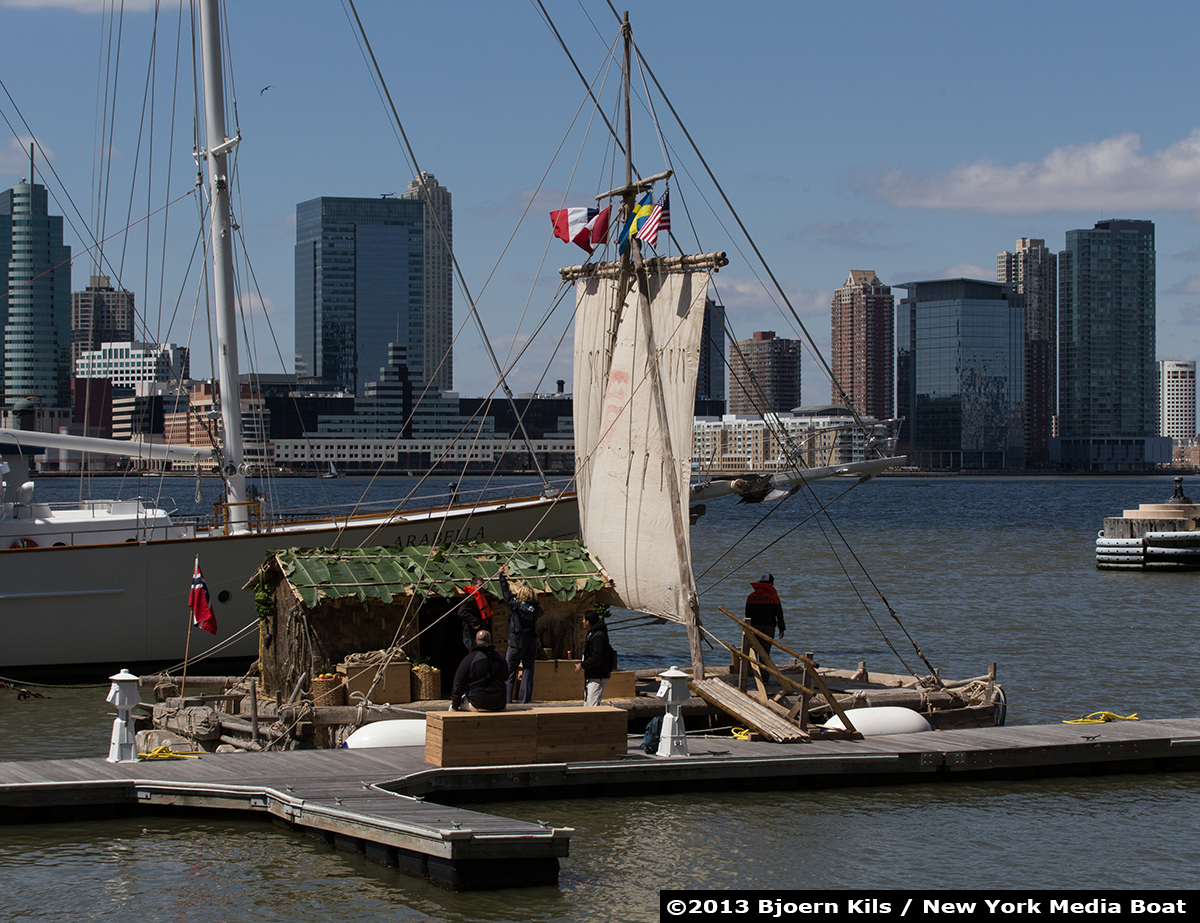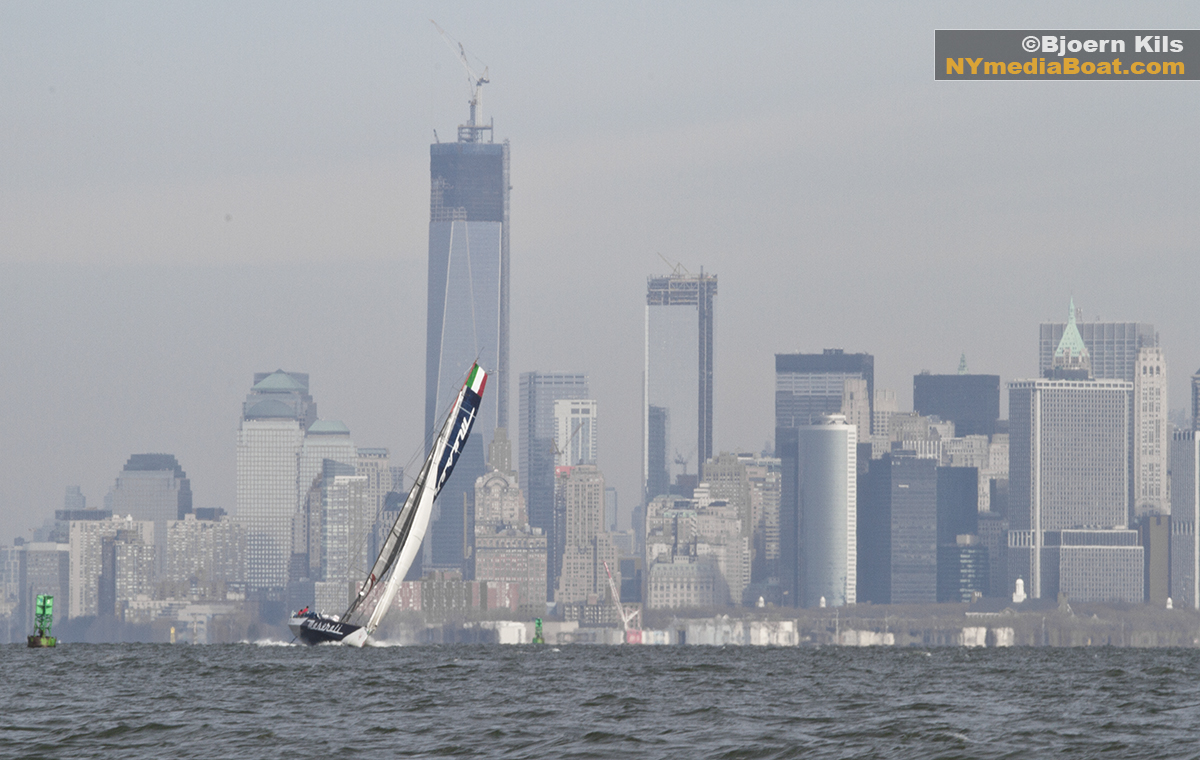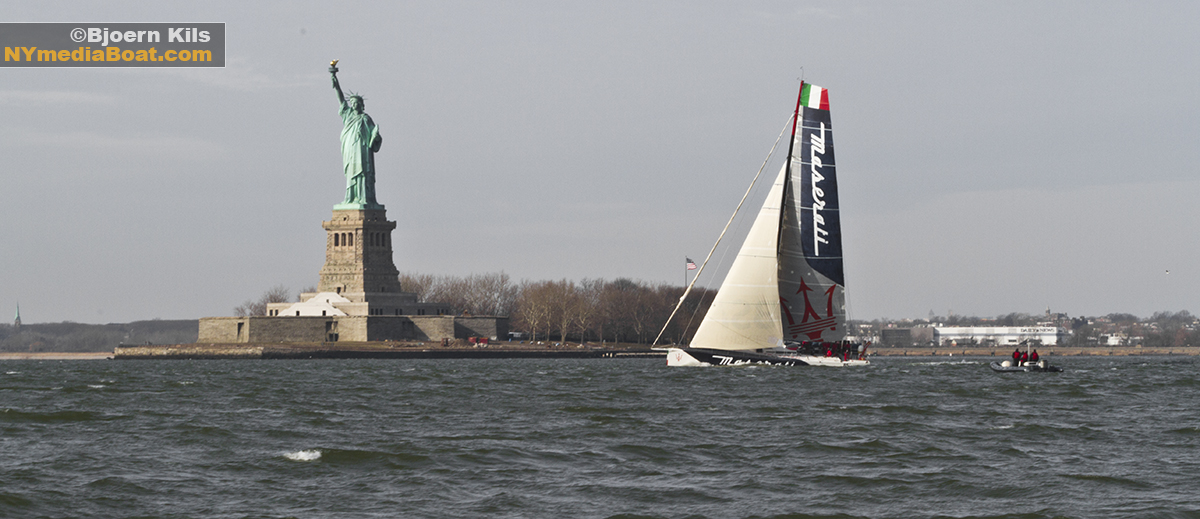Subsea Environmental Services removes old telecom cables from the ocean floor and recycles the materials.
Crane Delivery: Shanghai to New York
It was an impressive sight, as the four giant ship-to-shore cranes appeared on the Horizon.
On April 20th, the Heavy Load Carrier 'Zhen Hua 20' arrived in New York. She had departed Shanghai on February 15th -- that's 66 days at sea -- traveling at an average speed of just 8 knots.
The four cranes on deck were built by ZPMC in China for the Maersk Terminal at Port Elizabeth in New Jersey.
Many modern heavy load carriers are constructed with the wheelhouse forward of the cargo area for unobstructed views. On this ship, a box is mounted on the bow for the the look-out.
A clearview screen ensures a good view in any weather. This rotary wiper is installed in the window and houses an electric motor mounted in the center, which spins a glass disk inside the circular metal frame at high speed. Rain, sleet, and sea spray get dispersed immediately upon contact by centrifugal force.
Anchor was dropped in Gravesend Bay to reconfigure the total height in order to transit under the Verrazano-Narrows Bridge and the Bayonne Bridge.
With the booms lowered the total height was 213 feet. Three Moran tugboats assisted as she sailed through the Narrows into New York Harbor.
The iconic Manhattan skyline always makes for a nice backdrop!
One World Trade Center is currently the tallest building in the Western Hemisphere.
Stability calculations had to be exact in order to extend the booms this far from her port side.
The recently raised Bayonne Bridge was transited at low tide, allowing some extra room to pass underneath.
Tight quarters, but she made it!
New FDNY fireboat: WILLIAM M. FEEHAN
A massive water salute erupted in New York Harbor, as the newest FDNY fireboat arrived just after 3pm today. She is named after Firefighter William M. Feehan who died in the 9/11 attacks. The name plates with red letters crafted from I-beam steel collected at ground zero are displayed on each side of the wheelhouse.
Her 66-foot aluminum hull houses three C-18 Caterpillar engines for propulsion, delivering 1150HP each. Another 450HP Caterpillar C-9 engine drives the water pumps, and for additional pumping power, one of the main C-18 engines can be assigned to the main water canon. She delivers up to 7,000 gallons of seawater per minute and foam and purple-K additives are also on board if needed.
Her crew of five firemen consists of a pilot, an engineer, an officer and two deckhands -- safely housed inside the positive-pressure CBRNE (Chemical, Biological, Radiological, Nuclear and Explosives) filtration system equipped bridge.
The $4.7-million medium-sized fast-response boat built by MetalCraft Marine in Kingston, Canada will be stationed at MARINE 6 in the East River, at the Brooklyn Navy Yard.
Quantum of the Seas
At 11 times the size of a full-grown blue whale, Royal Caribbean’s ‘Quantum of the Seas‘ sailed into New York Harbor for the first time this morning, completing her maiden trans-Atlantic voyage.
Once past the Verrazano Narrows Bridge, the ‘North Star‘ glass capsule was raised on her top deck, providing passengers with a 360-degree view extending to the same height as the torch of the Statue of Liberty.
Complete with robotic bartenders, bumper cars, a FlowRider surf and RipCord iFlyskydiving simulator, she also features 375 interior staterooms with virtual balconies, projecting real-time views of the ocean. Wifi and RFID luggage tags allow guests to track their bags right from a smartphone.
At 1,141 feet long, ‘Quantum of the Seas’ is now the largest cruise-ship on the Hudson River, a status previously held by Norwegian Cruise Line’s 1,068-foot ‘Norwegian Breakaway‘.
Her homeport is the Cape Liberty Cruise Port in Bayonne, New Jersey and she’ll be christened there later this week.
Great North River Race
The tugs raced and pushed on the Hudson, and the crews had spinach eating, tattoo and line throwing contests.
Besides the regular harbor tugs, the ship that brought the biggest guns to the show was the US ARMY LT-803 Major General Anthony Wayne.
She took second in the race, but sure dominated the nose-to-nose pushing competition with her twin 11-foot diameter screws.
The Chief Warrant Officer closely monitored gauges in the engine room…
… as the skipper accepted our nose-to-nose challenge.
For additional write-ups of this event — and cool stuff in general — check these awesome blogs!
– Tugster 1 & Tugster 2
– WindAgainstCurrent
Race Weeks: Busy Months in New York Harbor
May and June have been packed will all kinds of boats and regattas.
First to show her sails after a long winter was the Super-Maxi luxury yacht Leopard 3. She can entertain 20 guests, reach speeds of 30+ knots under sail, and was docked at North Cove Marina.
The Class 40 Atlantic Cup boats completed Leg 1 with a spectacular slow finish, as the wind died and the tide switched (the yellowbrick tracker screenshot shows a trying last mile). They also docked at North Cove Marina and restarted a few days later on Leg 2, course set for Newport.
The $6 million French MOD70 trimaran ‘Virbac-Paprec’ stayed at Liberty Landing Marina to host corporate sponsor sails around Manhattan. New York Media Boat was the official photographer and we provided all transfers for their clients. The MOD70 got a mention in Sailing Anarchy when she was struck by a careless transient captain exiting Morris Canal. ‘Virbac-Paprec’ departed New York on June 1st for Kiel, Germany.
Fleet Week 2014 brought a couple of NAVY ships to town, most notably the USS Cole (DDG-67), which unfortunately didn’t make it up the bay to Manhattan and instead docked at Sullivans Piers on Staten Island. It was interesting to watch a Willard Marine 7 meter RHIB — the same craft we use here at New York Media Boat — being lowered off the USS Oak Hill (LSD-51).
North Cove Marina hosted the first OCEAN MASTERS regatta. All five IMOCA’s crossed the start line, as the canon was fired at 12:10 EST on June 1st. The Hungarian team retired within minutes and returned to port to refit their boat. They couldn’t do a 24hr turn-around after a very delayed arrival to New York. The 60 foot boats compete in this new dual handed race as part of the World Championship Series. It was great seeing Ryan Breymaier on (Hugo Boss) and Mark Guillemot (Safran Sailing Team) again. SAIL FAST!
Elliott Dale and Chris ‘Darby’ Walters launched their 19 foot long carbon/kevlar foam composite boat at Liberty Landing Marina to row the North Atlantic Ocean in under 55 days in an attempt to raise money for the Children’s Hospice South West.You canfollow their voyage here.
The Clipper Round the World race finished Race 13 from Jamaica to New York with the fleet spread over a hundred miles apart. ‘GREAT Britain’ was the first boat to arrive Manhattan and we welcomed them at the Verrazano-Narrows Bridge. It’s an interesting concept as each boat is skippered by one professional sailor and the rest of the crew made up of paying passengers — no experience required.
Our friend Giovanni Soldini is also in town with VO70 ‘Maserati’ for some PR sailing and is currently on stand-by for a North Atlantic record attempt. Also awaiting the right weather conditions is the 130 foot offshore-racing maxi trimaran ‘Banque Populair’. They hope to break their standing record of 3 days and 15 hours from Ambrose buoy in New York to Lizard Point in the UK.
New Cranes for Port Newark
The Port Newark Container Terminal is increasing capacity by taking delivery of three ZMPC Super-Post-Panamax ship-to-shore cranes as part of their $500 million dollar expansion project.
After a 13-week journey from Shanghai, the Chinese heavy load carrier ‘Zhen Hua 10’ is delivering the cranes, requiring expert navigation by the Sandy Hook Pilots and Metro Pilots, while entering the port, passing under the Verrazano-Narrows and the Bayonne Bridge.
The USCG established strict criteria in order to safely move the cargo into port:
— Visibility must be a minimum of 2 nautical miles
— Winds <20 Knots: 3 tugs are required / Winds <25 Knots: 4 tugs are required
— Daylight transit only
— Slack Water transit under the Bayonne Bridge
— Two Pilots onboard
The cranes will take about nine days to unload and three months to assemble. They can reach 22 rows of containers across the deck of a ship. The raising of the Bayonne Bridge and acquisition of these cranes enable Port Newark to accommodate the new fleet of supercargo ships.
Norway Bound
Norwegian sailor Halvard Eneberg decided to take on some extra diesel before casting off on Easter Sunday. “It’s cheaper in the U.S. than in Scotland,” he said while filling about 20 jerry cans — bringing his fuel total to 150 gallons. The Norwegian crew of three was in high spirits as they made final preparations aboard the 37-foot BalticVaerbitt, which translates to ‘weathered.’
“We went to Pathmark and bought enough food and beer to get us there and back,” Eneberg said.
In 2012, Vaerbitt was sailed by her previous owner from Norway via Spain and the Canary Islands to Saint Lucia and Panama before arriving in New York Harbor. She was put up for sale and Eneberg purchased her with the intent to sail her back to Norway. “We won’t take the northern route because of the ice, and we will head straight for the Azores,” he said.
Clearing U.S. Customs and donning New York Media Boat swag, the team departed Liberty Landing Marina in New Jersey at 18:00 ET, hoisted sail, and set course due east. The crew was looking forward to reaching international waters and exchanging their guest flag for a jolly roger.
More info on the boat, the voyage, and daily position reports at www.vaerbitt.net.
Mega-crane arrives New York
After a 6,000 mile tow, the ‘Left Coast Lifter’ mega-crane arrives in New York Harbor.
The 150-foot ocean going tug ‘Lauren Foss’, powered by twin diesels producing 8,200 horsepower, completed the move of the crane after leaving San Francisco less than six weeks ago. The voyage took them down the West Coast, through the Panama Canal and up the East Coast to New York.
The convoy of tug, barge, plus support vessel ‘Iver Foss’ passed under the Verrazano Bridge around 10 am this morning and is now docked in Bayonne, NJ.
The ‘Left Coast Lifter’ was previously used on the San Francisco – Oakland Bay Bridge project and will now assist with construction on the Tappan Zee and New New York Bridge.
On Assignment with the Sandy Hook Pilots
Over the summer, we spent a day at sea with the Sandy Hook Pilots on assignment for New Jersey Monthly. We watched them scale the Jacob’s ladders of giant oil tankers and container ships to steer these behemoths safely into port.
We’d ride with the launch back and forth between ships, picking up pilots and dropping them off. It was a gorgeous day, and could easily make you think the pilot’s life is for you. But change the setting to a freezing winter day with seas kicked up ahead of a nor’easter, and you start having second thoughts. The transfer from the launch to the ladder of a 1,000-foot container ship turns from a fun leap into one of life-or-death: it has to be timed precisely, lest you fall in the drink or get squeezed between two vessels.
That’s why Pilot personalities are the perfect blend of adventurous and competent. These guys have the responsibility of ensuring that billions of dollars’ worth of global trade arrives to final destinations in the ports of New York and New Jersey.
Check out the full Sandy Hook Pilots article and photo essay in the December issue ofNew Jersey Monthly — now on newsstands — or read it here at this link.
Power Players on the Hudson
Lots happening on the Hudson during this incredible extended summer — including stunning, contrasting examples of power.
On a recent photo excursion, we spotted the tail section of a submarine, possibly on its way to the NAVY shipyard in Groton, Connecticut. Will it be a ballistic missile sub, or an attack sub? Check out this piece from Undersea Warfare on how they put one of these together.
A little less intimidating — but no less exciting — was a visit from the BayCycle Project. Founder Judah Schiller straps two pontoons to his bike, which powers a propeller and pushes him across the water. In late September, he became the first person to bike across the San Francisco Bay, and last week, the first to pedal across the Hudson — without the help of a bridge, of course.
Nearly all U.S. submarines are nuclear powered. Schiller runs on elbow (knee?) grease. Quite the contrast of high-tech versus low-tech power.
Largest Solar Boat samples Gulf Stream
NEW YORK, June 18, 2013 — I got to sail a portion of the Gulf Stream aboard VO70 ‘Maserati’ from Charleston, SC to New York last winter. We took advantage of it’s 5 mile per hour northward flow and mild temperatures. Entering the stream, foulies and boots were quickly exchanged for t-shirts and flip flops.
The Gulf Stream gyres in the North Atlantic, transporting warm nutrient rich water from the tropics along the East Coast of the U.S. towards Europe. Eventually the water cools, becomes denser, sinks and starts flowing south as part of the North Atlantic Deep Water before resurfacing off Florida.
Some speculate that without the warm influence of the Gulf Stream North America and Europe would look more like Alaska – snowy tundras and vast ice fields.
Scientist from the University of Geneva are now taking a closer look at this 60 mile wide current that extends as far as 4000ft deep.
Climatologist Martin Beniston leads the DEEPWATER EXPEDITION joining the crew of the swiss catamaran ‘MS Turanor Planet Solar’ — the largest solar powered ship in the world — on her voyage from Miami to Bergen, Norway with stops in New York, Boston, St-John’s and Reykjavik.
Beniston deems the 82ft long vessel a suitable platform for scientific sampling. No gasoline or diesel are used for propulsion and voyages are made with zero CO2 emission, eliminating potential factors of data pollution. He and his team are studying the chemical and physical composition of water masses and aerosols.
New York Media Boat spoke with Deepwater Expedition team member Dr. Bastiaan Ibelings, a professor in microbial ecology at the University of Geneva who explains the importance of phytoplankton for our oceans and climate.
The 82 foot long ‘MS Turanor PlanetSolar’ is part of a Swiss initiative to demonstrate how innovative technology can harvest renewable energy and allow clean travel. 5,500 square feet of photovoltaic cells supply power for the twin 60kW electric motors moving her averaging 5 knots.
Five World Records have been established by ‘MS Turanro PlanetSolar’ including ‘first earth circumnavigation by solar-powered boat’ and ‘fastest transatlantic crossing completely under solar power’ in 26 days. Note: French sailer Francis Joyon crossed the North Atlantic in just over 5 days powered by wind earlier this week.
Be sure to stop by the boat currently docked at North Cove Marina before she leaves on Thursday for Boston.
UPDATE 6/20/13 — PHOTO GALLERY: ‘MS Turanor PlanetSolar’ departs NY, sailing past Lower Manhattan, The Statue of Liberty, and the Brooklyn Bridge
IDEC & Atlantic Cup in New York
Lots of great boats in New York Harbor this week! Leopard3 (ICAP) visited North Cove Marina for some corporate sailing before heading over to the UK. She’s a 100ft super maxi yacht designed by Farr Yacht Design and powered with Doyle Stratis sails. Two hydraulic cylinders operating the 61 ton canting keel keep her vertical and the VIP guest safe. Talking about Farr boats… check out Halcyon Sailing, NYC — they just launched 4 Farr30’s in the harbor for corporate sailing and racing leagues.
Francis Joyon arrived Sunday on the 97ft maxi-trimaran IDEC 2 to stage for his next trans-atlantic record attempt, which will most likely take place sometime in June. He hopes to break Thomas Coville’s 2008 record of 5d, 19h, 29 min. Check out these photos of IDEC from yesterday’s shoot in New York Harbor!
Tuesday night the Atlantic Cup boats arrived after sailing 642 nm non-stop from Charleston — finishing Leg 1 of the double handed race. New York Media Boat met the lead class 40 boat ‘Bodacious Dream’ (USA 118) crewed by skipper Matt Scharl and owner Dave Rearick as they sailed under the Verrazano Bridge and towards the finish line at North Cove Marina. Check out the photos here!
Check out our short & exclusive video and come to North Cove Marina to meet the skippers.
Kon-Tiki arrives in New York
A few days ago we showed you one of the world’s most decked-out private yachts —the $1.5 billion Eclipse.
Today, on the other side of the spectrum but just a few miles south on the Hudson, floats the world’s most primitive seagoing raft — the Tangaroa.
From a distance, it appears to be Thor Heyerdahl’s Kon-Tiki built by the Norwegian explorer to show that people from South America could have settled Polynesia from the east, contrary to popular belief. They constructed Kon-Tiki from balsa wood and hemp rope — the same materials available before Columbus’ time. Heyerdahl and his crew navigated by the stars and ocean currents, and put down some respectable 4,300 nautical miles before wrecking Kon-Tiki on a reef in theTuamotu Islands after 101 days at sea. Heyerdahl’s 1947 expedition across the Pacific was a huge success: it made him Norway’s most famous person, his book became an international best seller, and their documentary won an Academy Award in 1951.
The raft currently docked at North Cove Marina is a replica and did not sail from Norway to New York, but was delivered by container ship instead. It’s here as a promotional stunt to highlight the newly released 2012 action movie ‘Kon-Tiki,’ nominated for a 2013 ‘Best Foreign Language Film’ Oscar.
Tangaroa however was not built to promote the movie, but rather float the Humbold Current as well. In 2006 a Norwegian team led by Olav Heyerdahl, grandson of Thor Heyerdahl, constructed the replica-raft in an attempt to duplicate the original Kon-Tikivoyage. They too crossed the Pacific, made landfall in the Polynesian Islands, anddocumented their voyage.
If you want to climb aboard Tangaroa, swing by North Cove Marina in Battery Park City. I’m told the raft is open to the public and will be there until April 22nd.
The movie opens in select U.S. theaters on April 26 so check out the trailer, and if you’re ever in Oslo, I highly recommend a visit to the Kon-Tiki Museum at Bygdøy.
Oligarch Eclipsed by Saudi Royals
We almost caught a glimpse of the world’s largest private yacht, but we were a day late.
Russian oligarch Roman Abramovich’s 536-foot Eclipse had just been eclipsed by a new addition to the Saudi royal family’s fleet: the 590-foot Azzam launched in Germany late last week.
Even though it was now only the world’s second largest private yacht, Eclipse was an impressive sight from just outside the 100-yard security perimeter. She needed a berth usually reserved for major cruise liners. Her main antenna, specked with half a dozen satellite domes, jutted into the skyline. Her six decks looked as if they could fold down into one giant floating Matryoshka doll.
Somewhere on board this behemoth, reportedly, there’s a submarine, a disco, a movie theater, two swimming pools, two helipads, and likely more secondary vessels than former soviet leaders.
She’s even rumored to have a missile defense system – and lasers to disable cameras.
Luckily, we couldn’t confirm either of those things.
Word is that the $1.5 billion Eclipse will be in New York until mid-April, when Abramovich’s girlfriend is expected to give birth to their child. After that, she’ll likely bebattling with the $600 million Azzam over Caribbean anchorages.
Who’s Clocking Maserati?
NEW YORK – Maserati is on track to take the New York to San Francisco monohull speed record. But who’s keeping time?
That would be the World Sailing Speed Record Council, or WSSRC. Its New York commissioner Janet Hellman officially clocked the Volvo Open70 as she left Manhattan for forty-something days at sea.
Hellman is an executive assistant at the Sandy Hook Pilots, which always have a vessel stationed at Ambrose Buoy, the official starting line for the race. The Pilots visually confirmed Soldini crossing that line and entered it into their ship’s log book.
Check out our video interview with Hellman, and come back later this week for Bjoern’s images and coverage of Maserati’s arrival at the Golden Gate Bridge.
Around the Horn in 40 Days
American sailor Ryan Breymaier raised a thin metal pipe and chipped away at a layer of ice that had formed overnight on parts of Maserati’s deck.
Skipper Giovanni Soldini took a sip of hot tea from a friend on the dock and lit a cigarette to stay warm.
“We are looking forward to go and reach the hot water as soon as possible because it’s cold,” Soldini told me as we shivered in the morning light at North Cove Marina, where the crew was readying Maserati for her departure.
“When we reach the Gulf Stream,” he said, “the air will be warmer and life will be easier.”
The week was the coldest that Soldini and his crew of eight had experienced since they arrived in New York on December 4. They were awaiting the ideal conditions to make a run for the New York to San Francisco monohull world record: 57 days.
The northwest winds on this last day of 2012 were exactly what the modified Volvo Open 70 needed to push her “just south of east,” as navigator Boris Herrmann described the initial heading of 110 degrees. The 14,000-mile route first stretched the team south and eastward into the Atlantic almost the length of the continental U.S., around the elbow of Brazil, down the South American coast and ‘round the treacherous Cape Horn.
Then they’d rush back up north through the Pacific Ocean almost midway between French Polynesia and Chile, across the equator for a second time, and into San Francisco.
Since it’s impossible to predict the weather 40 days out – their target time, as they’d also like to take the overall record of 43 days, held by the catamaran Gitana – the forecast for the first week is critical. Soldini said the day’s increasing northwest winds, ultimately predicted to reach 35 to 40 knots, would help slingshot them well north of Bermuda, and eventually into the trade winds.
“If everything goes to plan, we could be in 10 days at the equator,” Herrmann said on the dock at North Cove at around 8 am on the last day of the year. “We hopefully only suffer two days from this cold.”
After hitting the easternmost point of Brazil, Maserati will stay close to the South American coast all the way to Cape Horn, where she’ll likely pass through the Le Maire Strait into the Drake Passage.
Soldini, Braymeier, and Herrmann have all been ‘round the horn, but never “the wrong way around,” Herrmann said.
“I’ve been around two times,” Soldini told me, “but in the good direction!”
Herrmann said that there’s a 60% chance the winds will be working against them, with the likelihood of favorable winds at “just a few percent.”
And the odds are high that they’ll have a low-pressure system waiting for them there.
“Getting around Cape Horn without having to stop and wait … is key to success with this record,” Breymaier said. “If you can get around quickly and get moving north again, you’re golden. If not you could sit there for a long time.”
Soldini said a storm could stymie them for up to a week. And once they get through, they’re still only halfway there. The next part of the voyage takes them far off the Chilean coast, thousands of miles offshore and possibly half way to the French Polynesian islands.
Then it’s back across the equator and up the North American coast – the “upwind part at the end that could be a little bit boring,” Breymaier says – and finally in to San Francisco.
“It could happen that we have to make a big detour” to get into San Francisco, Herrmann says. “It depends on the weather we find there. That’s too far away now to predict.”
Herrmann has tried to predict it, though. He’s run models for the trip based on 20-year historical weather data and the best routes put them in San Francisco in 42 days.
The average, though, is 55 days, and some – when the weather was never in their favor — put them in San Francisco much later.
The caveat is that the historical models were of “very low resolution,” Herrmann says, relying on weather information from only 12-hour intervals. But they don’t clash too much with the sailors’ intuitions.
“The multihull record is 43 days – that’s 16.5 knots average for the course, which is pretty high,” Breymaier told me after the ice had been hacked away. “We’re dreaming we can make it in 42 and say we have the overall record, but that’s certainly not a safe bet to make.”
“I think we’re gonna be somewhere between 45 and 50.”
The increasing winds – and the chill they brought – upped the crew’s motivation to leave, and by 10 am Maserati had pushed back from the dock at North Cove and sailed out into the Hudson.
Soldini said they haven’t made any definite plans if they do make it all the way around, but if they complete this historical route, there will be a “big party, first thing,” he says. “Then we’ll see.”
Interview mit Boris Herrmann in New York (German)
Kurz bevor Giovanni Soldini und crew in New York ablegten, sprach Navigator Boris Herrmann exklusiv mit ‘New York Media Boat’. Das Team versucht mit der 70 Fuss (21 Meter) langen Volvo Ocean Race Yacht ‘Maserati’ einen neuen Rekord von New York nach San Franzisko zu erstellen. Gestern segelten sie vor Manhattan an der Freiheitsstatue entlang, zur offiziellen Startlinie bei ‘Ambrose Light’ und Herrmann hofft in etwa zwanzig Tagen Kap Horn zu umrunden.
After the Storm
After successfully relaunching ‘Aperture’ at Liberty Harbor, we got right back to business.
CNN put a TV crew on board to get exclusive footage of the devastation Hurricane Sandy caused to Coney Island, the Rockaways and Staten Island. Maneuvering through the floating debris was challenging despite having stationed a spotter at the bow, dodging telephone poles, trees, logs, even partial docks that were making their way down the Hudson. Norton Point was hit hard. The ocean literally came into peoples living rooms and many houses were simply gone. The Rockaways were still smoldering from the extensive fires; Old Orchard Lighthouse knocked down, and many half-sunken boats adrift in the Lower Bay, and washed ashore at Staten Island and Sandy Hook.
Atlantic Highlands Marina didn’t fare well. We observed dive teams from as far away as Texas working around the clock raising sunken vessels with lift bags, and clearing paths for the commuter ferries to resume service. USCG cutters and NAVY ships were stationed just offshore, providing security and other support functions to the hard-hit communities. The port condition was set at YANKEE – restricting all recreational boats and only permitting commercial vessels to transit.
Great Kills Harbor was a sad sight as well. It seemed like a total loss of the marina. While some boats turtled and sunk at their moorings, most were piled on top of each other at the western side of the basin — many impaled by pilings as the water from the 13.8 foot storm surge receded. Other TV crews and still photographers also came aboard that week following Sandy’s landfall and we were able to document the destruction before NYPD stationed a patrol boat at the entrance closing the marina.
We put down hundreds of nautical miles surveying the shorelines, and whenever we came across floating debris dangerous to navigation we reported it’s position to the Coast Guard’s VTS.
This sure was an epic storm.
Fabio Buzzi Races New York to Bermuda
Fabio Buzzi talks about his record attempt just minutes before he departed Liberty Landing Marina at 16:00ET on September 27, 2012. He set a new record of 17 hours and 6 minutes running his FB41 — a 40-foot boat originally designed and built by him for military use, and powered by twin 650HP diesel inboards — from New York to Bermuda. Leaving the marina, his waterline sat 3 inches below as he was laden with 900 gallons of fuel. His crew of five included Roberto Rizzo (pilot and responsible for on-board electronics), Antonio Binda (engineer and chief mechanic of FB Design, he physically built this boat!), Emilio Riganti (pilot), and Maurizio Bulleri (Italian TV/magazine journalist, and former offshore pilot). The photo above shows Buzzi passing Ellis Island as he left New York Harbor.



